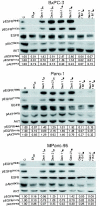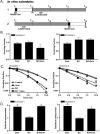The combination of epidermal growth factor receptor inhibitors with gemcitabine and radiation in pancreatic cancer
- PMID: 18698032
- PMCID: PMC2699587
- DOI: 10.1158/1078-0432.CCR-07-4072
The combination of epidermal growth factor receptor inhibitors with gemcitabine and radiation in pancreatic cancer
Abstract
Purpose: Gemcitabine-radiotherapy is a standard treatment for locally advanced pancreatic cancer. Clinical data have shown that gemcitabine plus erlotinib is superior to gemcitabine alone for advanced pancreatic cancer. Therefore, we investigated the effects of the combination of epidermal growth factor receptor inhibitors with gemcitabine and radiation on a pancreatic cancer model.
Experimental design: EGFR signaling was analyzed by measuring phosphorylated EGFR (pEGFR(Y845, (Y1173)) and AKT (pAKT(S473)) protein levels in pancreatic cancer cell lines and tumors. The effects of scheduling on gemcitabine-mediated cytotoxicity and radiosensitization combined with erlotinib were determined by clonogenic survival. In vivo, the effects of cetuximab or erlotinib in combination with gemcitabine-radiation on the growth of BxPC-3 tumor xenografts were measured.
Results: We found in vitro that gemcitabine induced phosphorylation of EGFR at Y845 and Y1173 that was blocked by erlotinib. Treatment of BxPC-3 cells with gemcitabine before erlotinib enhanced gemcitabine-mediated cytotoxicity without abrogating radiosensitization. In vivo, cetuximab or erlotinib in combination with gemcitabine-radiation inhibited growth compared with gemcitabine-radiation (time to tumor doubling: gemcitabine + radiation, 19 +/- 3 days; cetuximab + gemcitabine + radiation, 30 +/- 3 days; P < 0.05, erlotinib + gemcitabine + radiation 28 +/- 3 days; P < 0.1). Cetuximab or erlotinib in combination with gemcitabine-radiation resulted in significant inhibition of pEGFR(Y1173) and pAKT(S473) early in treatment, and pEGFR(Y845), pEGFR(Y1173), and pAKT(S473) by the end of treatment. This study shows a novel difference pEGFR(Y845) and pEGFR(Y1173) in response to EGFR inhibition.
Conclusions: These results show that the EGFR inhibitors cetuximab and erlotinib increase the efficacy of gemcitabine-radiation. This work supports the integration of EGFR inhibitors with gemcitabine-radiation in clinical trials for pancreatic cancer.
Figures




Similar articles
-
In pancreatic carcinoma, dual EGFR/HER2 targeting with cetuximab/trastuzumab is more effective than treatment with trastuzumab/erlotinib or lapatinib alone: implication of receptors' down-regulation and dimers' disruption.Neoplasia. 2012 Feb;14(2):121-30. doi: 10.1593/neo.111602. Neoplasia. 2012. PMID: 22431920 Free PMC article.
-
Mechanisms of resistance to Erbitux (anti-epidermal growth factor receptor) combination therapy in pancreatic adenocarcinoma cells.J Gastrointest Surg. 2004 Dec;8(8):960-9; discussion 969-70. doi: 10.1016/j.gassur.2004.09.021. J Gastrointest Surg. 2004. PMID: 15585383
-
Proteasome inhibition activates epidermal growth factor receptor (EGFR) and EGFR-independent mitogenic kinase signaling pathways in pancreatic cancer cells.Clin Cancer Res. 2008 Aug 15;14(16):5116-23. doi: 10.1158/1078-0432.CCR-07-4506. Clin Cancer Res. 2008. PMID: 18698029 Free PMC article.
-
Her signaling in pancreatic cancer.Expert Opin Biol Ther. 2007 Jun;7(6):823-9. doi: 10.1517/14712598.7.6.823. Expert Opin Biol Ther. 2007. PMID: 17555368 Review.
-
New therapeutic directions for advanced pancreatic cancer: targeting the epidermal growth factor and vascular endothelial growth factor pathways.Oncologist. 2008 Mar;13(3):289-98. doi: 10.1634/theoncologist.2007-0134. Oncologist. 2008. PMID: 18378539 Review.
Cited by
-
Altering the response to radiation: radiosensitizers and targeted therapies in pancreatic ductal adenocarcinoma: preclinical and emerging clinical evidence.Ann Pancreat Cancer. 2018 Aug;1(8):26. doi: 10.21037/apc.2018.08.02. Epub 2018 Aug 31. Ann Pancreat Cancer. 2018. PMID: 32656528 Free PMC article.
-
Treatment of pancreatic cancer with epidermal growth factor receptor-targeted therapy.Biologics. 2009;3:419-28. Epub 2009 Sep 15. Biologics. 2009. PMID: 19774209 Free PMC article.
-
Tissue of origin dictates GOT1 dependence and confers synthetic lethality to radiotherapy.Cancer Metab. 2020 Jan 2;8:1. doi: 10.1186/s40170-019-0202-2. eCollection 2020. Cancer Metab. 2020. PMID: 31908776 Free PMC article.
-
Epithelial to mesenchymal transition contributes to drug resistance in pancreatic cancer.Cancer Res. 2009 Jul 15;69(14):5820-8. doi: 10.1158/0008-5472.CAN-08-2819. Epub 2009 Jul 7. Cancer Res. 2009. PMID: 19584296 Free PMC article.
-
Superior efficacy of the antifungal agent ciclopirox olamine over gemcitabine in pancreatic cancer models.Oncotarget. 2017 Dec 8;9(12):10360-10374. doi: 10.18632/oncotarget.23164. eCollection 2018 Feb 13. Oncotarget. 2017. PMID: 29535812 Free PMC article.
References
-
- American Cancer Society. 2007. Cancer Facts and Figures.
-
- McGinn CJ, Zalupski MM, Shureiqi I, et al. Phase I trial of radiation dose escalation with concurrent weekly full-dose gemcitabine in patients with advanced pancreatic cancer. J Clin Oncol. 2001;19:4202–8. - PubMed
-
- Burris HA, 3rd, Moore MJ, Andersen J, et al. Improvements in survival and clinical benefit with gemcitabine as first-line therapy for patients with advanced pancreas cancer: a randomized trial. J Clin Oncol. 1997;15:2403–13. - PubMed
-
- Storniolo AM, Enas NH, Brown CA, Voi M, Rothenberg ML, Schilsky R. An investigational new drug treatment program for patients with gemcitabine: results for over 3000 patients with pancreatic carcinoma. Cancer. 1999;85:1261–8. - PubMed
-
- Murphy JD, Adusumilli S, Griffith KA, et al. Full-dose gemcitabine and concurrent radiotherapy for unresectable pancreatic cancer. International journal of radiation oncology, biology, physics. 2007;68:801–8. - PubMed
Publication types
MeSH terms
Substances
Grants and funding
LinkOut - more resources
Full Text Sources
Other Literature Sources
Medical
Research Materials
Miscellaneous

